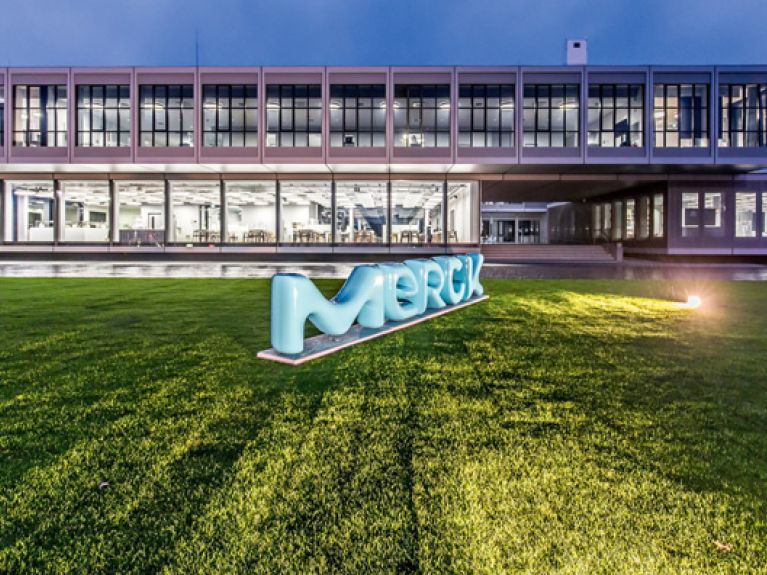German-American innovation for health
There is wide-ranging transatlantic cooperation in the pharmaceutical and biotech industries.

Out by the big highway towards the north, there’s a lot going on in Darmstadt. Anyone looking to the left on Frankfurter Strasse when driving out of the city in south Hessen in the direction of the Frankfurt conurbation will soon spot the laboratory and factory buildings of pharmaceuticals and chemicals corporation Merck. Until just a short time ago, a striking glass pyramid stood here, but the corporation, which is listed on the DAX, the leading German stock index, tore it down. The foundation stone has just been laid for an Innovation Center, scheduled to be completed in 2018 just in time for the 350th anniversary of the company’s foundation. There is also to be a new corporate identity, with a new logo in bold colors: the corporation, which likes to call itself the oldest pharmaceutical and chemical company in the world, is currently riding a wave of confidence.
At the same time it has managed to overcome a substantial crisis, at least in its biggest division, which is research-driven business involving patent-protected single-source drugs. For almost three decades the firm’s scientists have been researching and developing in vain, bringing none of their own new active agents onto the market. But that is soon to change – thanks to help from the United States. Merck has agreed to a joint venture with US market leader Pfizer, which should lead to the development of a lucrative cancer drug from its own laboratory. Avelumab is its name, and it belongs to the class of immuno-oncology drugs, the new pharmaceuticals that aim to stimulate the defense system of the patient’s own body to fight the tumor.
On the verge of a breakthrough
If the new drug is successful then it will represent a turning point in Merck’s pharmaceutical research. The chances are pretty good: recently the American approval authority, the FDA, gave the experimental drug the status of a potential “therapeutic breakthrough”, which means an accelerated authorization procedure. That currently applies for a very particular type of tumor, but could mark the start of broader applications.
America plays a considerable role in the research and development of the German pharmaceutical industry. It was to the US that Merck turned in search of resources more than ten years ago: the company acquired the rights to cancer drug Erbitux from ImClone and developed it ready for marketing. ImClone would probably not have managed to do so alone, whilst for Merck the development represented the nucleus of an entirely new area of research. This helped a little in making up for the stagnation in its own labs. Today, from a commercial perspective Erbitux is the corporation’s second most important drug, with turnover of a good 900 million euros a year. Thus the two core Merck pharmaceutical division projects were both developed in cooperation with American partners.
Varied partnerships
This is not surprising, as the USA is the world’s leading pharmaceuticals developer. Merck’s competitor Bayer has also been known to team up with Americans, for example for the cancer drug Nexavar. The laboratories in Wuppertal found the active ingredient, but it was developed in cooperation with Onyx. Bayer also reached an agreement with the Munich-based unit of American corporation Amgen to develop and market a new antibody – yet another alliance to fight cancer.
Research alliances are commonplace in the pharmaceutical industry: they make it possible to spread the enormous costs and risks involved in the development of new drugs. Boehringer Ingelheim – Germany’s second-largest pharmaceutical corporation behind Bayer and ahead of Merck – has been working with Eli Lilly on a range of diabetes therapies since 2011. Biotech companies too are happy to look to the USA to combine strengths. Germany actually has the United States to thank for a large part of its biotech industry funding, as German investors have been reluctant to take the risk ever since the biotech bubble burst around the millennium. Biontech in Mainz dropped a bombshell in May 2015: the company had received 60 million dollars from Eli Lilly as part of a cancer alliance. Curevac, a Tübingen-based developer of cancer medicines and vaccinations, secured an injection of 52 million dollars in the spring from the Bill & Melinda Gates Foundation. At the beginning of 2015 Curevac went one better, garnering 100 million euros from institutional investors – the biggest sum a German biotech company has received when raising equity outside the stock markets. And once again, a large part of the money is coming from the United States. Hamburg-based Evotec, for its part, is working with the American National Cancer Institute. Together, they are managing a suite of possible active agents: as recently as October 2015 a corresponding contract was extended by five years. ▪
